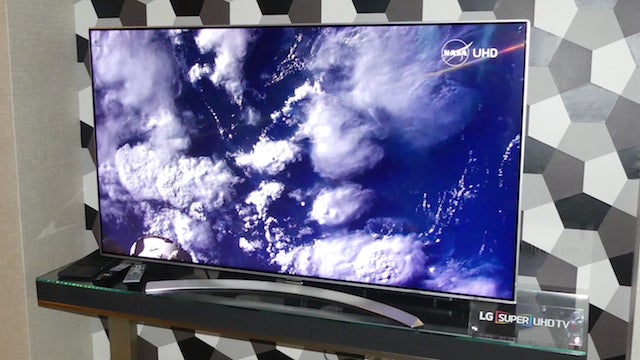LG 65UH9500 Super UHD TV Review
LG 65UH9500 Super UHD TV
Hands-on: Super UHD LCDs attempt to grab the limelight from their OLED siblings

Verdict
Key Specifications
- 65-inch LCD TV
- Native UHD resolution
- HDR playback
- webOS 3.0 smart system
With LG’s new range of OLED TVs doing a pretty good job of stealing this year’s CES, the Korean brand’s LCD sets find themselves in the potentially awkward position of playing a distant second fiddle to their more glamorous siblings.
The simple fact of the matter, though, is that even though some of LG’s new OLED TVs are likely to be cheaper than ever before, they still won’t be cheap enough to reach really mass market levels. So LG still needs to be in the LCD business. And on paper, at least, its new range of Super UHD LCD TVs look easily capable of competing with anything other brands might have to offer.
The UH9500 series we’re looking at here (as represented by the 65-inch model) sits near the top of multiple series of Super UHD models, with the UH8500 and UH7700s sitting below and just one model, the 86-inch UH9550 sitting above. The Super UHD designation tells you at a glance that each TV has both a native UHD resolution and the ability to play high dynamic range (HDR) content.
To help them deliver on their HDR promises, all Super UHD models benefit from a new LG Colour Prime Plus system that employs new LCD phosphors in conjunction with a chunkier colour filter to expand the range of colours LG’s LCD technology can deploy. In fact, LG says Super UHD TVs such as the 65UH9500 can deliver around 90 per cent of the Digital Cinema Initiative (DCI) P3 colour spectrum.
Brightness is boosted to the sort of levels demanded by HDR content, and LG has introduced new processing technology it claims is capable of turning non-HDR sources into images that at least look closer to an HDR experience.
With LG’s IPS panels tending to struggle with black level response over the years, it’s also good to learn that the Super UHD TVs leverage new True Black Panel designs and Contrast Optimizer features to try and keep black levels looking good despite the extra brightness. An Ultra Luminance feature claims to extend the distance between the brightest whites and blackest blacks, too.
Finally the sets all benefit from LG’s third generation of WebOS and are reckoned to be capable of producing a billion different colour tones thanks to their use of both a 10-bit panel and 10-bit processing power.
The main difference between the 65UH9500 and its cheaper Super UHD alternatives is its design, which is just 6.6mm deep, features a very attractive ‘one layer’ fascia and impressively trim screen frame, and benefits from a Harman Kardon-designed speaker system.
As we’d expect given how well liked it is, the new webOS generation delivers iterative rather than revolutionary changes. The highlights are a feature that lets you magnify any part of the picture you wish; the ability to include broadcast and IPTV ‘channels’ in a single favourites list; improved interoperability with external smart devices; and a new Search button on the remote control.
We suggested earlier that it must be tough for LG’s Super UHD TVs to share floorspace with the brand’s mostly rapturously received OLEDs, and the bottom line is that they fall so far short of those OLEDs that it’s almost embarrassing. Certainly it’s no surprise to find LG taking care not to put any of these LCDs right alongside any of its OLEDs on its CES stand.
First, though, credit where its due. The 65UH9500’s pictures enjoy a clear upshift in colour saturations and brightness from previous LG LCD efforts, and there’s a definite sense of expansion in these areas when the TV is fed an HDR source.
The 65UH9500 does a good job of delivering the sort of detail and crispness you’d expect of a UHD TV too, helped by a very welcome increase in colour resolution versus previous LG LCDs. Skin tones and subtle blends no longer appear to suffer with the sort of blocking or slight cartoonishness sometimes seen in the past.
Unfortunately, though, it doesn’t take long standing in front of the 65UH9500 to discover that even the addition of new contrast technologies hasn’t fixed LG LCD’s long-standing issues with black level response.
Areas of an image that should look black still look distractingly grey, and as we’ve seen so many times before, the local dimming technology LG uses to try and improve its contrast issues results in large and clear light bands and blocks around any bright objects that appear against relatively dark backgrounds.
These over-obvious reminders of the technology inside the Super UHD TVs were visible in both a heavily windowed hotel suite and on the brightly lit LG CES stand, so they’re not just ‘dark room’ problems.
It must be said, too, that the lack of a convincing black level response from the Super UHD TVs seems to reduce their HDR impact, as the brightness peaks don’t have very profound blacks to stand out against.
It doesn’t seem that any of the Super UHD TVs have been granted Ultra HD Premium status (see our separate story), and our guess would be that this is because they can’t hit the 0.05 Nit minimum luminance demanded by Ultra HD Premium’s specification recommendations.
We don’t have any pricing information on the Super UHD models yet, but unless it turns out that we can calibrate away their apparent ongoing contrast problems (something which is, it must be said, certainly possible) we’re not sure they’re really going to be competitive in today’s marketplace at any price.
How we test televisions
We test every TV we review thoroughly over an extended period of time. We use industry standard tests to compare features properly. We’ll always tell you what we find. We never, ever, accept money to review a product.

